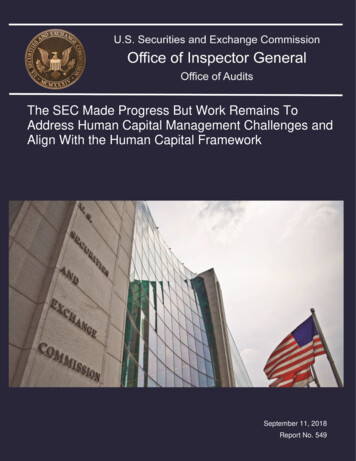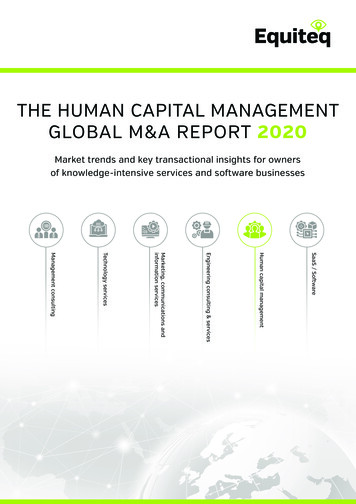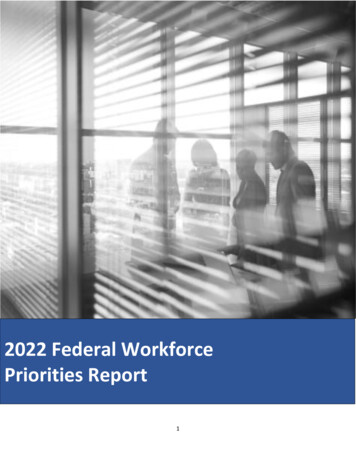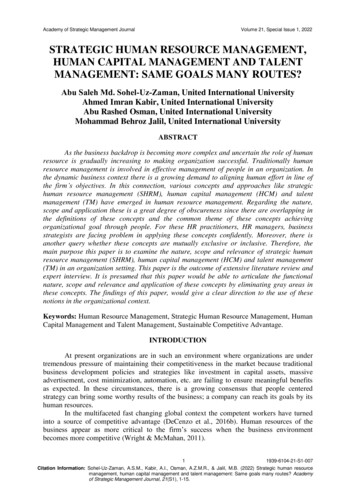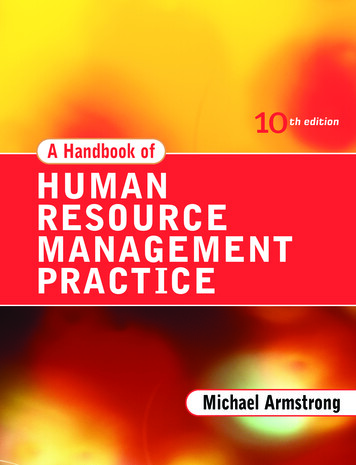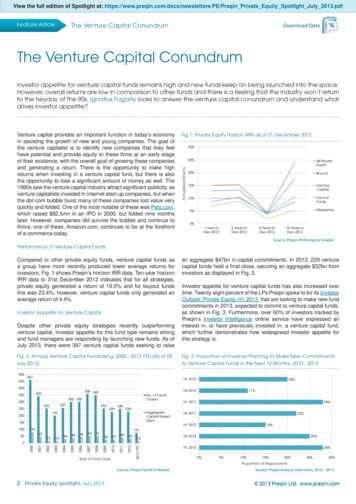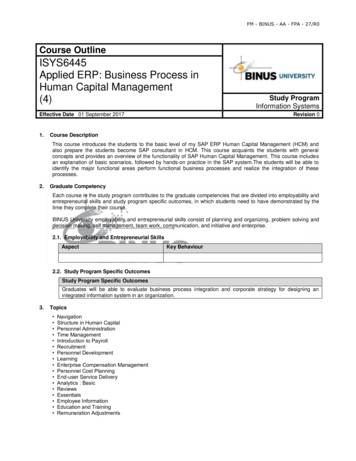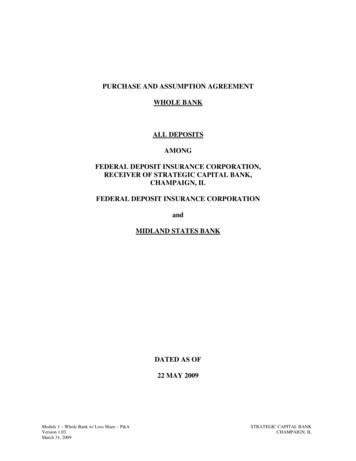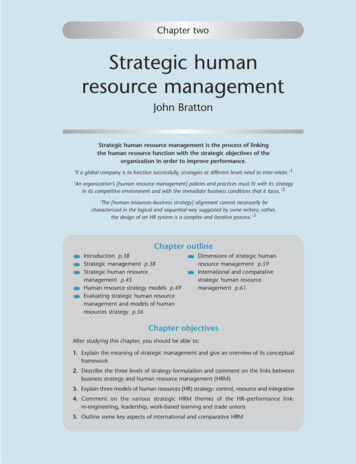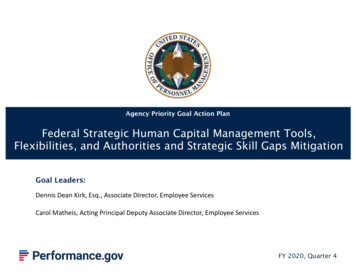
Transcription
Agency Priority Goal Action PlanFederal Strategic Human Capital Management Tools,Flexibilities, and Authorities and Strategic Skill Gaps MitigationGoal Leaders:Dennis Dean Kirk, Esq., Associate Director, Employee ServicesCarol Matheis, Acting Principal Deputy Associate Director, Employee Services1FY 2020, Quarter 4
Leadership & Implementation TeamGoal StatementEnable agencies to effectively address current and projected workforce needs to meetmission objectives. By September 30, 2021, OPM will provide agencies with at least 48significant tools, flexibilities, and authorities needed to advance their human capitalobjectives, and mitigate skill gaps in 80 percent of identified high risk mission criticaloccupations compared to a 2017 skills gap baseline.ChallengeWhile Chief Financial Officer (CFO) Act agencies are growing more sophisticated inaddressing Strategic Human Capital Management challenges and mitigating their highrisk Mission Critical Occupations (MCO) skills gaps, Strategic Human CapitalManagement has remained on the GAO High Risk for years. CFO Act agencies areengaging in a systematic process of addressing MCO skills gaps, but more progress needsto be made. Moreover, agencies require additional tools and flexibilities to assist them inmeeting their human capital objectives and identifying emerging workforce needs andskills, as automation continues to change the way work is accomplished.Implementation RiskCurrently, agencies can seem less anticipatory, and more reactionary about workforceneeds. This goal aims to help agencies shift to a more future-focused posture, by fullyleveraging tools, flexibilities, and authorities and implementing rigorous human capitalmanagement methodology.OPM cannot control the level of effort that each agency will put into closing their skillsgaps or using the tools, flexibilities, and authorities OPM provides.Agencies will need to put effort into closing their skills gaps and using the tools,flexibilities, and authorities OPM provides. Agency Subject Matter Experts will be2
Overview (continued)required to assist with multiple aspects of this goal. Without the appropriate personnel,the results may not be robust enough to mitigate skills gaps.The risk is moderate to low as OPM evidence reflects that agencies are devoting therequired resources to achieve this goal.OpportunityThe Federal Government is postured to advance Strategic Human Capital Managementusing real-time tools, flexibilities, and authorities, as well as forward-leaning strategicworkforce planning, to enable agencies to hire, develop, and retain the right talent, inthe right place, at the right time.Through the implementation of 5 CFR 250 subpart B, OPM can support agencies inachieving their human capital objectives by: assisting with the analysis and execution of a validated methodology to mitigateskills gaps in Mission Critical Occupations (MCO) to include identifying high riskMCOs, conducting a root cause analysis, developing an action plan, setting targetsand monitoring progress; creating a foresight methodology to identify the emerging skills necessary for thefuture of Federal work and proactively engaging agencies to use theserecommendations to shape their workforce components; and increasing Government efficiency by being less reactive and more proactive to: (1)identify significant tools, flexibilities, and authorities needed to advance humancapital objectives; and (2) spot trends impacting the future Federal workforce, tohire, develop, and retain the right talent, in the right place, at the right time.3
Overview (continued)OPM regulation 5 CFR 250 subpart B supports Federal departments and agencies in their ability to implement Strategic HumanCapital Management across their varied missions. This regulation creates the framework for agencies to align the human capitalnecessary to achieve their strategic plans while creating a mechanism for monitoring progress and achieving results. The illustrationbelow captures the four step process agencies use to conduct strategic workforce planning to achieve their goals. Based upon theforward-leaning findings of OPM’s Federal Workforce Priorities Report, agencies align their human capital strategies with the AgencyStrategic Plans, create a roadmap in their Human Capital Operating Plans (HCOP), and conduct data-driven “HRStat” Reviews on atleast a quarterly basis to monitor progress. Agencies then identify improvements and barriers on an annual basis during HumanCapital Reviews (HCR) with OPM. In turn, OPM provides guidance and identifies and develops tools, flexibilities, and authoritiesbased on Administration priorities, HCRs, and research.4
Overview (continued)5
Overview (continued)In 2011, OPM and the CHCO Councildeveloped and implemented a strategy onclosing skills gaps to remove Strategic HumanCapital Management from the GAO high risklist. The initial skills gap effort resulted in theidentification of five Government-wideMission Critical Occupations (MCOs) and onefunctional area of Science, Technology,Engineering and Math (STEM).In 2015, OPM designed a new methodologyfor identifying high-risk occupations using amulti-factor model. The Multi-Factor Model isa standardized, data-driven approach thatprovides consistency across Government. TheCHCO Council Executive Steering Committeereviewed and approved the model, providedinput, and recommended moving forward withthe Multi-Factor Model.The illustration above is an example of the multi-factor model and how the differentelements are used to determine if a mission critical occupation is high risk.The Multi-Factor Model is comprised of four distinct factors (2-year retention, quit rate, retirement rate, and applicant quality), eachhaving multiple dimensions that include Government-wide comparable data, as well as occupation specific data. OPM aggregatesagency findings and applies an e-scanning methodology to determine Government-wide high-risk occupations and Governmentwide high-risk competencies.6
Overview (continued)US Office of Personnel ManagementFederal Strategic Human Capital ManagementOversight and Program ManagementEmployee Services Dennis Kirk, Associate Director Carol Matheis, Senior Advisor John York, Deputy Associate Director, Strategic WorkforcePlanning Jason Barke, Group Manager, Forecasting andMethods, Strategic Workforce Planning Eric Popiel, Program Lead, Forecasting and Methods,Strategic Workforce Planning Rafiell Jones, Program Lead, Forecasting and Methods,Strategic Workforce PlanningEmployee ServicesSenior Leaders:Human Resources SolutionsSenior Leaders:Merit SystemAccountability and Compliance John York, Deputy AssociateDirector, Strategic WorkforcePlanning Sara Ratcliff, Associate DirectorSenior Leaders: Reggie Brown, Principal Deputy AssociateDirector Mark Lambert, Associate Director Kim Holden, Deputy AssociateDirector, Talent Acquisitions andWorkforce Shaping Leslie Pollack, Deputy Associate DirectorHR Strategy & Evaluation Solutions Brenda Roberts, Deputy AssociateDirector, Pay and Leave David LaCerte, Deputy AssociateDirector, Senior Executive Servicesand Performance Management Ana Mazzi, Princpial DeputyAssociate Director Dianna Saxman, Deputy AssociateDirector, Federal Staffing Center Tim Curry, Deputy Associate Director,Accountability and WorkforceRelations Samuel Wright, Deputy AssociateDirector, Outreach, Diversity &Inclusion7
Goal Structure & StrategiesRelated Strategic Objective: OPM Objective 3.1- Strengthen OPM coordination of policy, service delivery, andoversight resulting in agencies achievement of human capital objectivesOPM will provide agencies with at least 48 significant tools, flexibilities, and authorities and initiate 3 ongoingefforts needed to advance their human capital objectives. These items include: Issuing Regulations/Authorities:Providing Guidance/Memos:Tools/Resources:Ongoing Initiatives:1314213OPM will implement the following strategies to support goal accomplishment: Review Human Capital Operating Plans and Human Capital Review findings and other feedback fromagencies to identify agency needs. Identify, develop and release potential tools, flexibilities, and authorities to address needs. Conduct comprehensive Environmental Scan to determine what factors might impact Mission CriticalOccupations in the future. Collaborate with agencies and Subject Matter Experts, collect pertinent data, and determine the bestsolution to meet their needs.8
Summary of Progress – FY 20 Q4Closing Skill Gaps InitiativeDuring Q4 FY 2020, OPM continued to monitor agencies’ progress in mitigating skill gaps through the quarterly submissions processand technical assistance in support of their efforts. OPM is developing a revised multi-factor model with agency feedback and thesupport of a workgroup including DOD, DOE, DOJ, GSA, NASA, NSF and USDA. This tool will be used to identify agency-specific andGovernment-wide high-risk mission critical occupations. OPM will begin the closeout process for the last year of the four-year closingskill gaps initiative cycle in Q1 FY 2021 and expects to deploy the new multi-factor model in Q2 FY 2021.Pay and Leave Regulations and GuidancePaid Parental Leave for Federal Employees Interim Regulations: On December 20, 2019, President Trump signed into law a majorimprovement to the compensation and benefits package for Federal civilian employees. The new law amended the Family and MedicalLeave Act (FMLA) provisions in title 5, United States Code, to provide up to 12 weeks of paid parental leave to covered Federalemployees in connection with the birth or placement (for adoption or foster care) of a child occurring on or after October 1, 2020. OnAugust 7, OPM issued interim regulations to add new paid parental leave regulations to OPM’s leave regulations and make necessaryclarifications, changes, and additions to OPM’s FMLA regulations. On September 28th, OPM hosted a guidance briefing on the benefit.Notice of the Determination that the National Emergency Concerning the Novel Coronavirus Disease (COVID-19) Outbreak Constitutesan Exigency of the Public Business for the Purpose of Restoring Forfeited Annual Leave: On August 27, OPM notified agencies of thedetermination that the COVID-19 national emergency constitutes an exigency of the public business for the purpose of restoringforfeited annual leave.Interim Regulations on Scheduling of Annual Leave by Employees Performing Services Determined to be Essential for the Respon se toCertain National Emergencies: To avoid the cumbersome process for a large number of employees who have been required to workduring the COVID-19 national emergency, OPM has issued interim regulations that will allow agencies to continue to meet their vitalmissions while streamlining the process for restoration of annual leave for employees whose services are essential to respond to thisemergency.Continuation of National Emergency in Iraq: As a result of the President’s notice continuing the declared national emergency in Iraq,OPM issued revised guidance on September 11 regarding premium pay cap waiver authority for civilian employees working in qualifyingoverseas locations, including Iraq.9
Summary of Progress – FY 20 Q3OPM Guidance for the 2020 Presidential Election PeriodOPM issued a memorandum on Appointments and Awards During the 2020 Presidential Election Period on September 22nd, includingguidance concerning appointments, incentive awards, and other employment matters for all competitive and non-political exceptedservice appointment actions that involve the appointment or conversion of a current or former political appointee, Schedule Cemployee, or Noncareer SES member, as well as instructions for submitting requests for pre-appointment review.On September 29, OPM issued guidance on Flexibilities during the 2020 Election including information on the Federal Government’slongstanding policy of granting employees limited time off from work (that is, excused absence) to vote in Federal, State, county, ormunicipal elections, or in referendums on any civic matter in their community. This memorandum also encourages agencies to permitFederal employees to use available workplace flexibilities to volunteer to serve as a nonpartisan poll worker.Collective Bargaining Agreements public database:As of the end of FY 20, OPM has posted 987 collective bargaining agreements for the public database required under Executive Order(EO) 13836, Developing Efficient, Effective, and Cost-Reducing Approaches to Federal Sector Collective Bargaining, signed by thePresident on May 25, 2018, which requires agencies to submit each term collective bargaining agreement and its expiration date within30 days of the agreement’s effective date. EO 13836 requires OPM to make these agreements publicly available on the Internet. Thispromotes transparency by allowing the public to view the types of agreements reached between agencies and federal sector unions.Launch of the 2020 Federal Employee Viewpoint Survey with new questions addressing the COVID-19 pandemicOn September 14th, OPM began the administration of the 2020 OPM Federal Employee Viewpoint Survey. OPM updated the surveyduring the summer to achieve a responsive survey program. Responding to requests from multiple agencies to ease administrativeburden, OPM streamlined the core set of standard items for 2020. As in prior years, the survey will include widely used EmployeeEngagement and Global Satisfaction indices. A comprehensive section of questions addressing the COVID-19 pandemic will allow theidentification of ways in which employees continue to achieve missions in the face of an unprecedented pandemic. The rollout of resultsreports to agencies will begin in December, with most scheduled for release after the first of the year.10
Key MilestonesMilestone DueDateMilestone StatusIssue four tools, flexibilities, orauthoritiesQ1 FY 2020CompletedInitiate three ongoing effortsQ2 FY 2020CompletedIssue one tool, flexibility, orauthorityQ2 FY 2.3.4.5.6.7.Issue eight tools, flexibilities, orauthoritiesQ3 FY 2020Completed500 Series Classification GuidanceData Analytics Micro-learning SessionFederal Supervisory AssessmentsEmployee Engagement PlaybookForesight GuidanceHRStat COPCHCO Manager SurveySES AssessmentsOPM Memorandum - Human Resources FlexibilitiesAvailable for Federal Employees Impacted by the 2019Novel Coronavirus GuidanceOPM Memorandum - Preliminary Guidance to Agenciesduring Coronavirus Disease 2019OPM Memorandum On-boarding Processes for NewEmployees During the COVID-19 EmergencyCOVID-19 Surge Response Program via OpenOpportunitiesOPM Fact Sheet - COVID-19 Excepted Service HiringAuthorityOPM Fact Sheet - Options for Telework-EligibleEmployees with Caregiving Responsibilities1. Human Capital Review Report and Addendumrelease2. Gears of Transformation Tools Webinar3. Agile Federal Workforce Forum and Flysheets4. Federal Cybersecurity Workforce Summit andworkshops5. HRCOP Pilot for Staffing Professionals11
Key MilestonesIssue ten tools, flexibilities, orauthoritiesQ4 FY 2020Completed6. OPM Fact Sheet - Recruitment, Relocation, andRetention incentive waiver requests for COVID-19pandemic health crisis7. OPM Fact Sheet - Federal Employee Coverage underthe Leave Provisions of the Families First CoronavirusResponse Act (FFCRA)8. OPM Memorandum - Waiver of the Premium PayLimitation and Aggregate Pay Limitation forEmployees Working in Response to CoronavirusDisease 20199. OPM Fact Sheet - The Use of Flexible WorkSchedules in Response to Coronavirus Disease 201910. OPM Fact Sheet - The Use of a Maxiflex WorkSchedule in Response to Coronavirus Disease 20191. Paid Parental Leave for Federal Employees InterimRegulations and guidance webinar2. OPM Guidance - Notice of the Determination thatthe National Emergency Concerning the NovelCoronavirus Disease (COVID-19) OutbreakConstitutes an Exigency of the Public Business forthe Purpose of Restoring Forfeited Annual Leave3. Interim Regulations on Scheduling of Annual Leaveby Employees Performing Services Determined to beEssential for the Response to Certain NationalEmergencies4. OPM Guidance - Continuation of NationalEmergency in Iraq5. Development of the Collective BargainingAgreement database12
Key Milestones6. Launch of the 2020 Federal Employee ViewpointSurvey with new questions addressing the COVID-19pandemic7. OPM Guidance - Appointments and Awards Duringthe 2020 Presidential Election Period8. OPM Guidance - Flexibilities during the 2020 ElectionIssue four tools, flexibilities, orauthoritiesIssue four tools, flexibilities, orauthoritiesIssue eight tools, flexibilities, orauthoritiesIssue nine tools, flexibilities, orauthoritiesQ1 FY 2021On TrackQ2 FY 2021On TrackQ3 FY 2021On TrackQ4 FY 2021On-Track13
Key IndicatorsMeasureNumber of strategic human capitalmanagement tools, flexibilities, andauthorities provided to CFO Actagencies (Cumulative)Percent of CFO Act agencies thathave actively mitigated identifiedMission Critical Occupations skillgaps (conducted root cause analysis,submitted an action plan, developedtargets, and submitted quarterlyreports) (Cumulative)Number of CFO Act agencies thathave actively mitigated identifiedMission Critical Occupations skillsgapsNumber of CFO Act agenciesPercent of CFO Act agencies thatsuccessfully accomplished areduction in one or more of theMulti Factor Model categories (2year retention, quit rate, retirementrate, applicant quality) from their2015 baseline (Cumulative)Number of CFO Act agencies thatsuccessfully accomplished areduction in one or more of theMulti Factor Model categoriesNumber of CFO Act agenciesQ1 FY 20Q2 FY 20Q3 FY 20Q4 FY 20FY 20 YTDStatusFY 20 Year- End FY 21 4%G70%80%12121919---22 22 22 22 ---72.7%72.7%72.7%86.4%G70%80%16161619---22 22 22 22 --- Two CFO Act agencies do not have skills gaps as determined by workforce data and, as such, they have been removed from the denominator.14
Data Accuracy and ReliabilityMeasure 1Definition of Measure:Cumulative number of strategic human capital management tools, flexibilities, and authorities provided to CFOAct agencies.Data Source:OPM (divisions) database, data calls, OPM website, CHCO Council website, and surveys.Data Verification and Validation:OPM will check the agency and CHCO Council websites to verify that guidance was posted, and review responsesto surveys of OPM program offices / data calls for accuracy.Data Limitations:There are no significant data limitations.Measure 2Definition of Measure:Cumulative number of CFO Act agencies that have conducted root cause analysis, submitted an action plan,developed targets, and submitted quarterly reports to mitigate Mission Critical Occupations skills gaps divided bythe number of CFO Act agencies.Data Source:Quarterly reports from agencies, including milestone and metrics on their progress on closing skill gaps.Data Verification and Validation:OPM will review all quarterly submissions for accuracy, and work with individual agencies to resolve any issue.Data Limitations:There are no significant data limitations.15
Data Accuracy and ReliabilityMeasure 3Definition of Measure:Cumulative number of participating CFO Act agencies successfully accomplish a reduction in one or more of theMulti Factor Model categories (2-year retention, quit rate, retirement rate, applicant quality) from their 2015baseline divided by the number of CFO Act agencies.Data Source:Quarterly reports from agencies, including milestones and metrics on their progress on closing skill gaps.Data Verification and Validation:OPM will review all quarterly submissions for accuracy, and work with individual agencies to resolve any issues.Data Limitations:There are no significant data limitations.16
Additional InformationContributing ProgramsOPM Strategic Objective Goal 3.1: Strengthen OPM coordination of policy, service delivery, and oversight resulting in agenciesachievement of human capital objectivesPresident’s Management Agenda CAP Goal 3: Workforce for the 21st CenturyRegulations 5 CFR Part 250 subpart B, Strategic Human Capital ManagementGAO Priority Recommendation Strategic Human Capital Management on the GAO High Risk ListStakeholder / Congressional Consultations Federal departments and agencies Government Accountability Office17
addressing Strategic Human apital Management challenges and mitigating their high-risk Mission ritical Occupations (MO) skills gaps, Strategic Human apital Management has remained on the GAO High Risk for years. FO Act agencies are engaging in a systematic process of addressing MO skills gaps, but more progress needs to be made.
